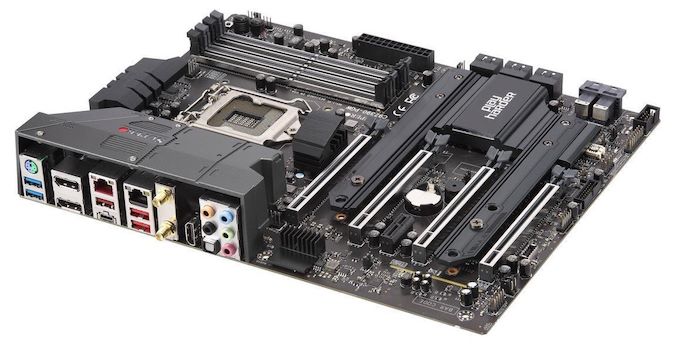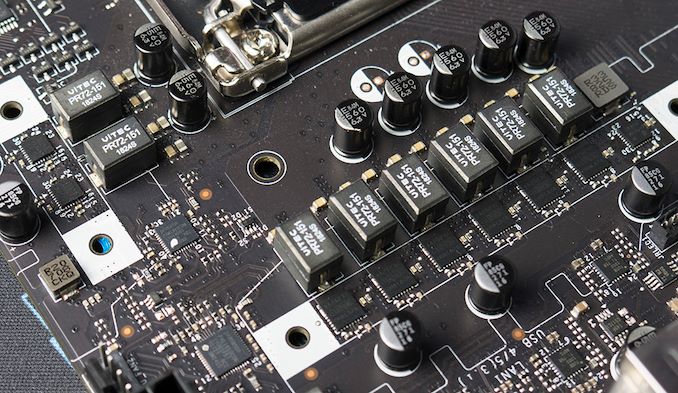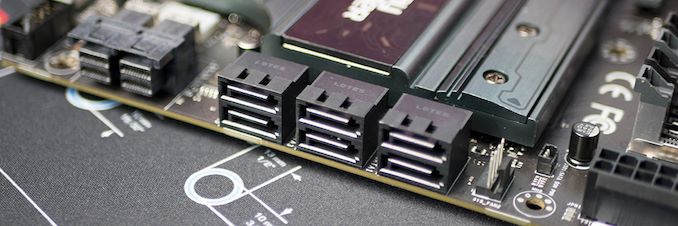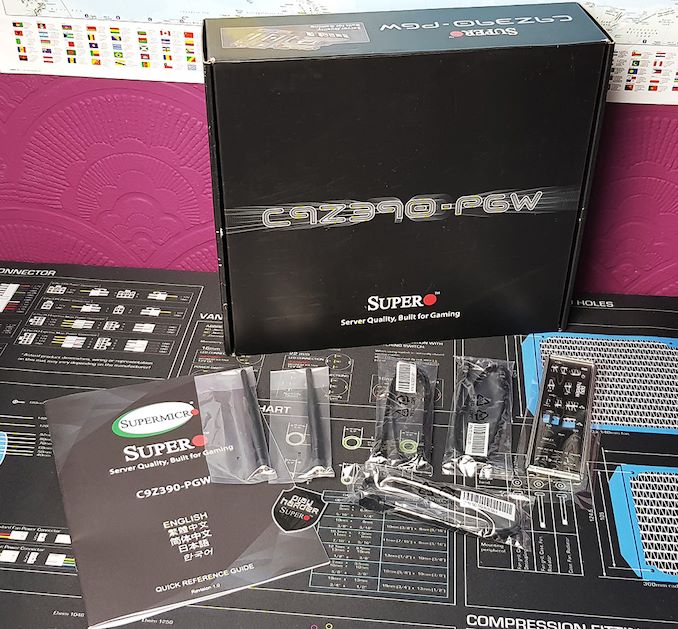The Supermicro C9Z390-PGW Motherboard Review: The Z390 Board With PLX and 10GbE
by Gavin Bonshor on February 1, 2019 9:00 AM EST- Posted in
- Motherboards
- Intel
- Broadcom
- Supermicro
- ATX
- PLX
- PLX8747
- Supero
- Z390
- C9Z390-PGW
- PEX8747
Visual Inspection
The Supermicro C9Z390-PGW ($371) is a full-sized ATX motherboard and is one of just four consumer desktop models from its SuperO series. The other three models include the C9Z390-CGW ($277), the entry-level C9Z390-CG ($209) and the mini-ITX C9Z390-CG-IW ($204). We reviewed the mini-ITX C9Z370-CG-IW last year.
Reminiscent of a militaristic vehicle, the C9Z390-PGW has an industrial looking rear panel cover which is made from plastic. Both of the power delivery heatsinks feature a gunmetal grey finish and are constructed of metal. For a visual effect, the C9Z390-PGW has four areas with integrated RGB LEDs including the rear panel cover, the audio PCB separation line, underneath the top right of the PCB by the memory slots, and within the chipset heatsink. Allowing users to add more RGB, Supermicro has included two 12 V RGB headers. The PCB is all-black in color and in-line with its more professional grade motherboards, Supermicro has used an epoxy glass resin with TU-62/NP175 materials; these materials are designed to improve signal quality through the traces and tracks between the components.
There are plenty of USB headers featured across the C9Z390-PGW. There are two USB 2.0 headers, two USB 3.1 G1 headers and one USB 3.1 G2 Type-C header. At the top right of the board is a clear CMOS button, an 'on' button and a reset button. There are also jumpers for the audio, the Intel Manufacturing mode, and to enable the Watch Dog function. Cooling capability consists of five 4-pin fan headers with one dedicated for a CPU fan, one for a 12 V pump and three for chassis fans.
The Supermicro C9Z390-PGW has four full-length PCIe slots which all feature metal slot reinforcement; located between these is a single PCIe 3.0 x1 slot. The biggest feature of the C9Z390-PGW is the use of a Broadcom PEX8747 PLX chip which muxes the processors PCIe lanes giving a total of 32 lanes. This makes true four-way NVIDIA SLI set-ups possible, while non-gaming applications such as FPGAs, RAID cards, and additional networking cards could make use of these slots.
| Supermicro C9Z390-PGW PCIe Layout | ||||
| Number of Installed PCIe Cards on CPU |
PCIe_1 | PCIe_2 | PCIe_3 | PCIe_4 |
| x1 | x16 | - | - | - |
| x2 | x16 | - | x16 | - |
| x3 | x8 | x8 | x16 | - |
| x3 | - | x16 | x8 | x8 |
| x4 | x8 | x8 | x8 | x8 |
Focusing on the power delivery on the C9Z390-PGW, Supermicro has gone with a simplistic but highly effective 6+2 design. Making up the CPU/VCore section is six Infineon TDA21232 50 A power stages with a complement of six Vitec 66 A inductors. The controller of choice for the VCore is the Primarion PXE1610 6+1 phase PWM controller. Similarly, the SoC uses two Infineon TDA21240 40 A power stages and is controlled by a Primarion PXE1310 3+1 phase PWM controller. The C9Z390-PGW is the epitome of a true 6-phase design for the CPU/VCore and although there is only one 8-pin 12 V CPU power input, this power delivery is more than capable of doing its job.
| Z390 Motherboard Power Delivery Comparison | |||||
| Motherboard | Controller | H-Side | L-Side | Chokes | Doubler |
| ASRock Z390 Taichi | IR35201 (5+2) |
TI 87350D (12) ON FDPC5939SG (2) |
14 | IR3598 (6) |
|
| ASRock Z390 Taichi Ultimate | IR35201 (5+2) |
TI 87350D (12) ON FDPC5939SG (2) |
14 | IR3598 (6) |
|
| ASRock Z390 Phantom Gaming 9 | IR35201 (5+2) |
TI 87350D (12) ON FDPC5939SG (2) |
14 | IR3598 (6) |
|
| GIGABYTE Z390 Aorus Master | IR35201 (6+2) |
IR3553 (12) |
14 | IR3599 (6) |
|
| GIGABYTE Z390 Aorus Ultra | ISL69138 (6+1) |
SiC634 (12) |
13 | ISL6617A (6) |
|
| GIGABYTE Z390 Aorus Pro WiFi | ISL69138 (6+1) |
SiC634 (12) |
13 | ISL6617A (6) |
|
| GIGABYTE Z390 Aorus Pro | ISL69138 (6+1) |
SiC634 (12) |
13 | ISL6617A (6) |
|
| GIGABYTE Z390 Aorus Elite | ISL69138 (6+1) |
SiC634 (12) |
13 | ISL6617A (6) |
|
| GIGABYTE Z390 I Aorus Pro WiFi | IR35201 (6+2) |
IR3553 (6) |
8 | - | |
| GIGABYTE Z390 Gaming SLI | ISL69138 (5+2) |
PPak (10) |
12 | ISL6617A (5) |
|
| GIGABYTE Z390 Gaming X | ISL69138 (5+2) |
PPak (10) |
12 | ISL6617A (5) |
|
| GIGABYTE Z390 UD | ISL69138 (5+2) |
PPak (10) |
12 | ISL6617A (5) |
|
| MSI MEG Z390 ACE | IR35201 (6+2) |
ON4C029N (12) |
ON4C024N (12) |
13 | IR3598 (6) |
| Supermicro C9Z390-PGW | PXE1610 (6+1) PXM1310 (3+1) |
TDA21232 (6) TDA21240 (2) |
8 | - | |
Looking at memory support, the C9Z390-PGW has support for DDR4-4000 memory and the four slots allow for a maximum of 64 GB. Powering the memory is a solitary Infineon TDA21240 40 A power stage with a Vitec 66 A inductor and is controlled by a Primarion PXE1110 PWM controller. The slots themselves have a metal coating and a single installation clasp for installation.
The storage options on the Supermicro C9Z390-PGW are plentiful with SATA, M.2 and U.2 ports all featured. The M.2 slots both feature their own individual heatsinks, with the bottom slot supporting up to M.2 22110 drives, while the top slot can accommodate up to M.2 2280 drives. Users looking to either speed their already high speed M.2 drives or create redundancy can make use of RAID 0 and RAID 1 arrays. The six SATA slots also support RAID including 0, 1, 5 and 10. Finishing off the storage options is a pairing of U.2 ports and these also offer RAID 0 and RAID 1 support. Regrettably, the storage connections do share bandwidth with each other in the following ways, but it isn't as bleak looking as other models we have seen:
- If M2_1 slot is populated, U2_1 is disabled and visa versa
- If M2_2 slot is populated, SATA3_4 and SATA3_5 is disabled and visa versa
Just like most Z390 motherboards, the C9Z390-PGW uses a Realtek ALC1220 HD audio codec. Added to enhance the quality of the front panel audio is a Texas Instruments OPA1612 operational amplifier and the area has a total of seven gold audio capacitors. This area also features a physical divide between the audio PCB and the rest of the board.
On the rear panel is a variety of ports including USB, video outputs and audio connectors. The bulk of the space is taken by the three USB 3.1 G2 Type-A ports, a single USB 3.1 G2 Type-C port and two USB 3.1 G1 Type-A ports. The C9Z390-PGW uses two network ports with one powered by an Aquantia ACQ107 10G controller and the other coming via an Intel I219V. The board's Wi-Fi is provided by an Intel 9560 802.11ac Wave 2 2T2R CRF module and is actually underplayed in the specifications by Supermicro; the Intel 9560 offers speeds of up to 1.73 Gbps and also allows users to use Bluetooth 5 devices. Users looking to make use the integrated graphics on supported processors can use the two DisplayPort 1.2 or the HDMI 2.0a outputs. The rear panel also has five 3.5 mm audio jacks and aS/PDIF optical output powered by the Realtek ALC1220 audio codec. Finishing off the rear panel is a PS/2 combo port.
What's in The Box
Included with the retail packaging is a basic set of accessories with four SATA cables, a black and silver IO shield, SATA cable stickers, a driver installation disk, a quick reference guide, a SuperO case badge and a pair of Wi-Fi antenna. The C9Z390-PGW is also available from Supermicro without retail packaging when purchased in bulk.
- Four Straight-Angle SATA cables
- Two Wi-Fi Antennas (2x2)
- Quick Reference Guide
- Metal SuperO Case Badge
- Rear IO Shield
- SATA Label Stickers
- Driver Installation CD


















42 Comments
View All Comments
Flunk - Sunday, February 3, 2019 - link
The 10 series cards don't have enough SLI connectors to run in more than 2x SLI without severely downgraded bandwidth. It takes both connnectors for a 2 card HB SLI bridge. For the 20 series the RTX 2080 is the cheapest card that supports SLI. Nvidia is definitely limiting SLI to the most expensive cards.FastCarsLike - Friday, February 1, 2019 - link
Pretty much abandonware. The z390 Master from Gigabyte is significantly better. Audio improvements, 10gb internet, 3x NVME slots (although capped to 3 gb/s), and significantly better support than Asus. In addition, supermicro is way too cautious in the bios department than other manufacturers. (Bought a brand new Skylake Xeon motherboard from them, and had to select "experimental" NVME x4 to run a 760p from Intel!) Not worthy of mainstream.JoeyJoJo123 - Friday, February 1, 2019 - link
I've had similar issues with a SuperO board with PLX chip in the past, probably 2 years. Very common 16GB DDR4 set of Corsair Memory (DDR4-3000, CL15), wouldn't post with XMP enabled. I had to submit a support ticket to see what they could do about getting the memory kit supported. They had to order the memory in and find some stable memory timings, and sent me over the list of timings I should change. (Yeah, quite a few of the memory subtimings beyond the main 5 or so needed configuring... One of those subtimings went from a default 8 cycles to 22 cycles or something.)I wouldn't say they provide terrible value or terrible boards, but uhhh... Sometimes you just want stuff to work out of the box, and right now they're still a bit behind the usual motherboard vendors in regards to ease of use to work with.
Rocket321 - Sunday, February 3, 2019 - link
It does, however, sound like they provided you with an amazing level of support. Above and beyond what I would have expected the response to be.StrangerGuy - Saturday, February 2, 2019 - link
Reviewing a mobo with 10GbE/PLX but not do any testing on both features seems to miss the whole point completely.The_Assimilator - Saturday, February 2, 2019 - link
Another swing and miss from Supermicro. SLI is going the way of the dodo and quad-SLI especially is already extinct, so the PLX chip is well-nigh useless. Then we have not one, but two U.2 ports which are also useless.I dunno, man. Every time I read a review of a SM board it's like they just grabbed a bunch of arbitrary features and threw them together without any thought as to whether they even make sense together.
"There are two USB 2.0 headers, two USB 3.1 G1 headers and one USB 3.1 G2 Type-C header."
It's pretty interesting how you supposedly did a visual inspection yet failed to notice there are not two, but one USB 2.0 header; ditto for the USB 3.0 header.
jabber - Sunday, February 3, 2019 - link
Yep I would just prefer 1x16/4x4Aenra - Saturday, February 2, 2019 - link
Lurker that couldn't help but (finally) comment..- Testing this board with a 8700K is not exactly ideal; one would have expected a 9900K, which you do own. A very bad start from the get go. No one can know what the board's really capable of, so there goes the entire review. Well done.
- You mention an LLC of 6, but without specifying what it entails; there are board manufacturers that use high numbers for lowest, others for highest. A serious omission here. Were you even aware?
- To add to the confusion (one thinks lack of understanding's the issue here), you criticise vdroop twice and that's before you even mention the LLC..
- You mention the PLX chip time and time again, but fail to even convince us you grasp of its downsides. A testing of any PCIe interface card other than GPUs would have been a good start towards that. Further testing performance with just a GPU to compare would've been even better.
- We've zero interest in the thermal throttling of your specific CPU, nor any knowledge as to whether it might be a 'dud', or not. Using its thermal throttling so as to 'comment' on the board's OC capabilities is.. ridiculous, sorry.
- Automated RAM timings are what's usually the make or break in terms of frequencies.. and you don't even mention how they're handled when on a manual RAM overclocking.
- Personally? I'm not sure you should be doing board reviews in the first place.
Not the first Anandtech review i see that is bad, but.. do please improve.
Korguz - Sunday, February 3, 2019 - link
Aenra... if you think you can do better.. then please do...Personally ? im not sure you would be able to do a better review...
yobbo7 - Saturday, February 2, 2019 - link
So, TU-62/NP175 are both mid-Tg generic FR4 class materials with a dielectric constant of over 4.This is standard stuff, it is not special at all and I would be surprised if anyone in the industry used anything worse on this class of motherboard.
There are still better materials available from the likes of Isola before you get into the RF materials like Rogers.